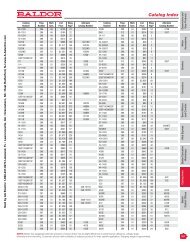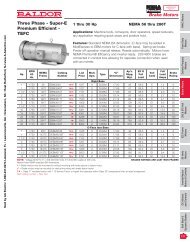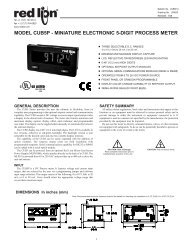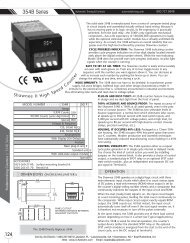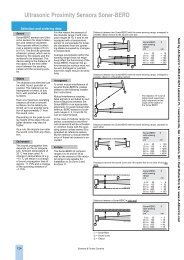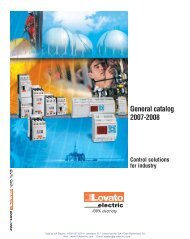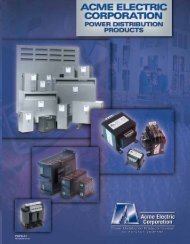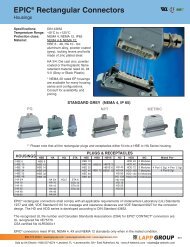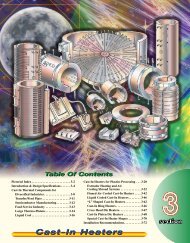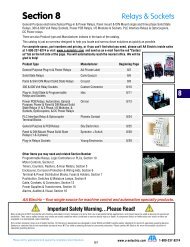You also want an ePaper? Increase the reach of your titles
YUMPU automatically turns print PDFs into web optimized ePapers that Google loves.
Technical Reference<br />
ence<br />
E = I x R<br />
OHM'S LAW is the relationship between current, voltage and resistance. It<br />
states that current varies directly with voltage and inversely with resistance.<br />
E (Electromotive Force or Voltage) is the electrical potential that exists<br />
between two points and is capable of producing a flow of current when a closed<br />
circuit is connected between the two points. The unit of measure for voltage is<br />
the volt (V). One volt will send one ampere of current through a resistance of<br />
one ohm.<br />
I (current) is the flow of electrons past a point in a specified period of time, usually<br />
one second. The unit of measure for current is the ampere (A). One ampere<br />
of current is 6.24 x 10 18 electrons passing a point in one second. Ampere is often<br />
shortened to amp.<br />
R (resistance) is the opposition to current flow offered by a resistive component.<br />
The unit of measure for resistance is the ohm. One ohm is the resistance<br />
through which a current of one ampere will flow when a voltage of one volt is<br />
applied.<br />
Ohm’s Law<br />
I 2 x R<br />
I x R<br />
E 2<br />
R<br />
Power<br />
Voltage<br />
P x R<br />
E x I<br />
(Watts)<br />
P<br />
E<br />
(Volts)<br />
P<br />
I<br />
E<br />
R<br />
Current<br />
I<br />
R<br />
(Amps)<br />
(Ohms)<br />
Resistance<br />
P<br />
I 2<br />
P<br />
E<br />
E<br />
I<br />
P<br />
R<br />
E 2<br />
P<br />
Ohms per 1000 ft<br />
AWG Dia. in. Dia. mm 0°C 20°C 50°C<br />
10 0.1019 2.588 0.92 Ω 0.99 Ω 1.12 Ω<br />
12 0.0808 2.052 1.46 Ω 1.59 Ω 1.78 Ω<br />
14 0.0641 1.628 2.33 Ω 2.53 Ω 2.82 Ω<br />
16 0.0508 1.290 3.70 Ω 4.02 Ω 4.49 Ω<br />
18 0.0403 1.023 5.88 Ω 6.39 Ω 7.14 Ω<br />
20 0.0320 0.812 9.36 Ω 10.15 Ω 11.35 Ω<br />
Temperature Conversions and Information<br />
The Celsius scale (°C), sometimes referred to as the “centigrade” scale, was<br />
devised by Swedish astronomer Andres Celsius (1701-1744) for scientific purposes.<br />
It has 100 degrees between the freezing point of 0°C and boiling point of<br />
100 °C of pure water at a standard air pressure of 29.92 inches of mercury. The<br />
term Celsius was adopted in 1948 by an international conference on weights<br />
and measures to replace the term centigrade. This is the most widely used temperature<br />
scale in the world.<br />
The Fahrenheit scale (°F) is used primarily in the United States. The freezing<br />
point of water is 32°F and the boiling point is 212°F while measured at a standard<br />
air pressure of 29.92 inches of mercury. 0°F was the coldest temperature<br />
Dr. Gabriel Daniel Fahrenheit (1686-1736) could create with a mixture of ice and<br />
salt. He is credited with the invention of the mercury thermometer introducing it<br />
and the °F scale in 1714. His thermometer was based on a design by Galileo.<br />
The absolute or kelvin (K) scale is used primarily for scientific work. It was<br />
invented by William Thomson, also know as Lord Kelvin. The hypothetical temperature<br />
characterized by a complete absence of heat energy and the point at<br />
which molecular motion would theoretically stop is –273.15°C or “absolute<br />
zero”. The kelvin scale uses this number as 0 K with divisions being the same<br />
as the Celsius scale. Temperatures on this scale are called kelvins, thus the<br />
degree symbol is not used with the capital “K” symbol, nor is the word kelvin<br />
capitalized when referring to the temperature units.<br />
The Réaumur scale was created by R A F de Réaumur (1683-1757). He used<br />
the freezing point of water as 0°Re and the boiling point at 80°Re. It was used<br />
in the 18th and 19th centuries mainly in France for scientific work, but is still<br />
used today by some European wine and cheese makers.<br />
W J M Rankine (1820-1872) created this scale, which was merely the kelvin<br />
scale using the Fahrenheit degree instead of the Celsius. It has been used in<br />
some scientific and thermodynamics work but is not commonly used today.<br />
Typical Solid Copper Wire Resistance<br />
Ohms per 1000 ft<br />
AWG Dia. in. Dia mm 0°C 20°C 50°C<br />
22 0.0254 0.6451 14.87 Ω 16.14 Ω 18.05 Ω<br />
24 0.0201 0.5105 23.65 Ω 25.67 Ω 28.70 Ω<br />
26 0.0159 0.4038 37.61 Ω 40.81 Ω 45.63 Ω<br />
28 0.0126 0.3200 59.80 Ω 64.90 Ω 72.55 Ω<br />
30 0.0100 0.2540 95.10 Ω 103.20 Ω 115.40 Ω<br />
32 0.0080 0.2032 151.20 Ω 164.10 Ω 183.40 Ω<br />
Resistance may vary ±10% or more depending on impurities, alloys, coatings, state of annealing, etc. Always check wire manufacturer’s specifications.<br />
From To Formula<br />
Fahrenheit Celsius °C = (°F – 32) / 1.8<br />
Fahrenheit kelvin K = (°F + 459.67) / 1.8<br />
Fahrenheit Rankine °Ra = °F + 459.67<br />
Fahrenheit Réaumur °R = (°F – 32) / 2.25<br />
Celsius Fahrenheit °F = °C × 1.8 + 32<br />
Celsius kelvin K = °C + 273.15<br />
Celsius Rankine °Ra = °C × 1.8 + 32 + 459.67<br />
Celsius Réaumur °R = °C × 0.8<br />
kelvin Celsius °C = K – 273.15<br />
kelvin Fahrenheit °F = K × 1.8 – 459.67<br />
kelvin Rankine °Ra = K × 1.8<br />
kelvin Réaumur °R = (K – 273.15) × 0.8<br />
Rankine Celsius °C = (°Ra – 32 – 459.67) / 1.8<br />
Rankine Fahrenheit °F = °Ra – 459.67<br />
Rankine kelvin K = °Ra / 1.8<br />
Rankine Réaumur °R = (°Ra – 459.67 – 32) / 2.25<br />
Réaumur Celsius °C = °R × 1.25<br />
Réaumur Fahrenheit °F = °R × 2.25 + 32<br />
Réaumur kelvin K = °R × 1.25 + 273.15<br />
Réaumur Rankine °Ra = °R × 2.25 + 32 + 459.67<br />
BSOLUTE ROCESS NSTRUMENTS, Inc.<br />
10<br />
© Absolute Process Instruments, Inc. 11/04 api-usa.com<br />
Sold by <strong>AA</strong> <strong>Electric</strong> 1-800-237-8274 Lakeland, FL • Lawrenceville, GA • Greensboro, NC • East Rutherford, NJ www.A-Aelectric.com



